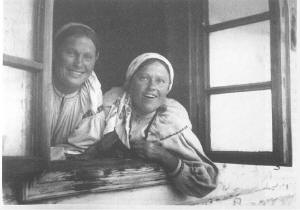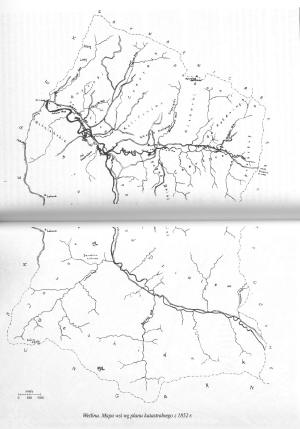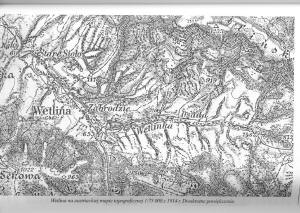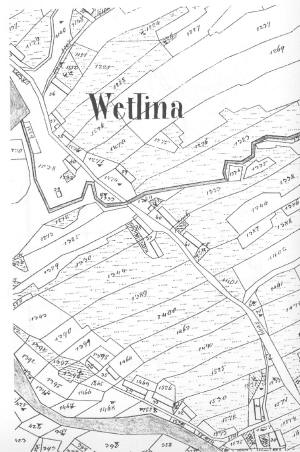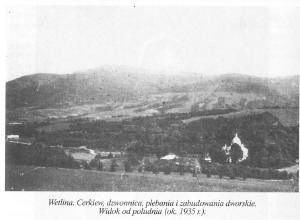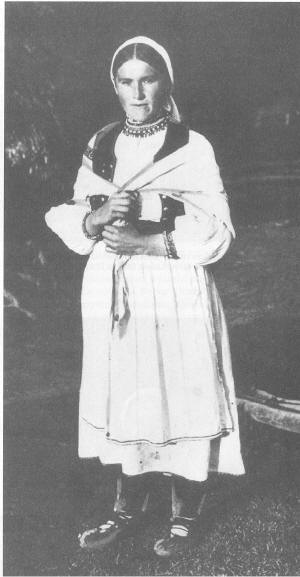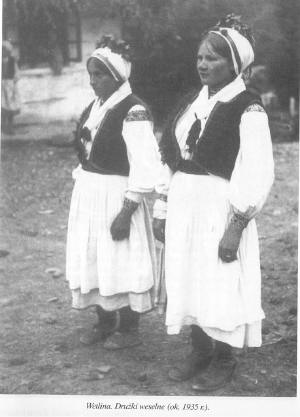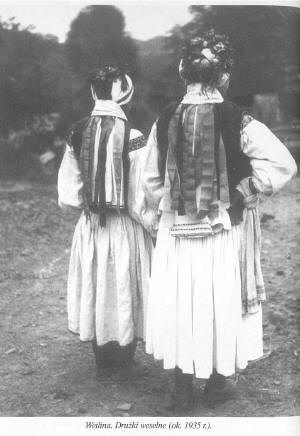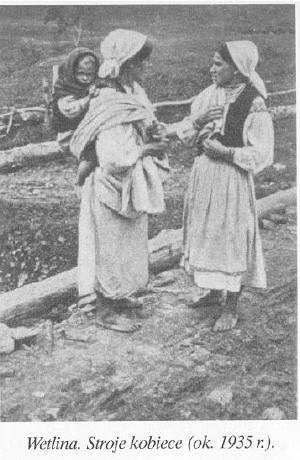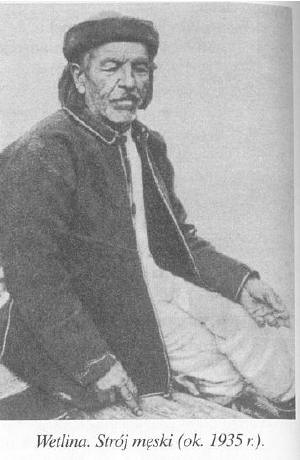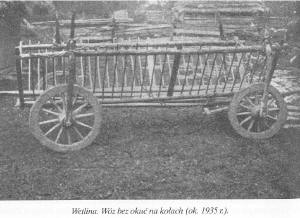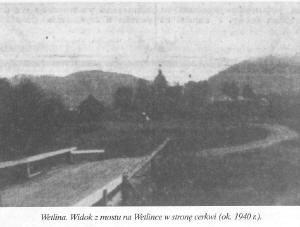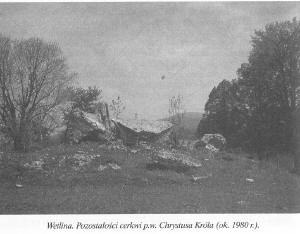| Slovakia Genealogy Research Strategies | ||||||
| Home | Strategy | Place Names | Churches | Census | History | Culture |
| TOOLBOX | Contents | Settlements | Maps | FHL Resources | Military | Correspondence |
| Library | Search | Dukla Pass | ||||
WETLINA, POLAND
BIESZCZADY Slownik Historyczno-Krajoznawcy
Book 2, GMINA CISNA, Warsaw, 1996
Marcin Gruszczynski, Wojciech Krukar, Stanislaw Krycinski
Towarzystwo Karpackie, Wydawnictwo Stanislaw Krycinski
(Wetlina Chapter), pages 380 to 423
Transcription Notes:
1. Text Translation by M. Spierings. Table translation and transcription, Bill Tarkulich, 2001-2003
2. Not all photos and maps are reproduced here, though most historic photos are included.
3. Ambiguities or translation difficulties are stated.
Table of Contents
4. Estate
6. Industry
Cisna County
1. Name
Wethlina 1580; Wetlina 1589; in Wetlina 1618; Wetlina 1745, 19th and 20th century; Ukrainian: Wetlyna. The name comes from a Ukrainian noun Wetlo, Wetlyna which means a kind of willow. The oldest written name of the village probably comes from the word “wetchij” which means old or ancient.
2. History
The village was located in the highest part of the valley of Wetlinka (Polish for Small Wetlina) stream and was organized according to the Walachian Law. The village was a part of the Kmita family property. The first time it was mentioned in writing was in 1580 as a fully inhabited village. Again in 1580, because of the division of the estate according to the will of Barbara Herbut, the widow of Piotr Kmita, Wetlina became the property of Katarzyna and Stanislaw Herbut.
According to the local tradition the village was settled in sequence, first Stare Siolo (Old Village), then Zabrodzie (By-the-River), and then the highest situated part of the village - Osada (Settlement). This has been supported by a written source in 1594 mentioning Great Wetlina and Small Wetlina. People who settled in Wetlina came most probably from the neighboring village called Moczarne, which was owned by the Polish king and was founded at the end of the 16th century in the valley of the river Upper Solinka. The movement from Moczarne to Wetlina must have taken place most probably at the beginning of the 17th century. It was known as fact is that Moczarne was deserted before 1629, partially due to the high mortality caused by the disease, partially due to being killed by robbers and highwaymen, and partially because a lot of people just abandoned their homes. One of the families that arrived from Moczarne was named Kohut. The owner of Wetlina at that time was Lukasz Boguski. The village belonged to the Boguski family until the sixties of the 17th century when it became a part of a dowry of Helena Boguska who married Jan Lipski. Their grand daughter Teresa married Michal Count Konarski in the first half of the 18th century. The village remained in the hands of Konarski family until the First World War. The manor house in the village had belonged to 8 generations of Konarskis. They also owned the villages of Lutowiska and Chrewt.
More or less every fifteen years, some sort of an epidemic ravaged the village. For example, in the three summer months of 1801, 13 children died of smallpox.
Jan Kanty Podolecki, the folklore researcher, who lived in Rzepedz in the years 1820-1840, wrote a poetic story entitled “Hnatowe Berdo”, on the basis of the legends that he had heard in the area. It was published in 1835 in the journal “Home Museum” (no. 19, pgs. 146-148). His version of history was a bit dramatized and poetized. According to the inhabitants of Wetlina one of the stories told the following:
“In the Carpathian Mountains, on the Hungarian border, there is a mountain which is called after the Ruthenian prince Ihnatija, whose castle was on the top of the mountain. During the Tatar invasion, seeing that the attackers are capturing the castle, the prince, trying to flee to the Hungarian side of the mountain, jumped from the mountain and killed himself.”
In 1846, the Treasury Guard from Wetlina, Jozef Neronowicz, took part in an unsuccessful uprising and was sentenced to 15 years in prison.
In 1868 the village covered 6123.4 ha, of which 4183.3 ha were woods. Farmers’ land included 677.4 ha of farmland, 589.3 ha of meadows and gardens, 190.5 ha of pastures and 16.7 ha of woods. (1 ha is approximately 2.2 acres)
Between 1883 and 1885 Oskar Kolberg conducted ethnographic studies in the Bieszczady Mountains. Most probably he never reached Wetlina but he wrote some short comments about the village stating that the “Highlanders from Bereh, Wolosaty, Ustrzyki Gorne and Wetlina already add the ending “lem” to the verbs”.
Even in the 20th century, in Wetlina stories circulated about Oleks Dowbusz. One of them described how he came to Wetlina in a coach pulled by 4 horses and lived in the manor house for 2 years. There were also stories about him and Gnat’s Berda. Apparently there were two rooms there with floors made of stone and Oleks Dowbusz and Gnat, the latter being incredibly strong and muscular, used to have meetings there. Also, in the Polonina Osadzka (Settlement Pasture), close to one of the today’s hotels, there used to be the Dowbusz’s highwaymen shelter. People also talked about the castle on the Rybia Skala (Fish Rock).
Figure 1: PAGE 382-383 Wetlina. Cadastral Map in 1852
Figure 2: Wetlina Austria Topographical Map, 1914
Figure 3: Wetlina Starego Siolka Map, 1852
In the village there is a hill called Szybenycia, where, according to the word of mouth, the peasants who refused to work the master’s fields were hung.
At the beginning of the 20th century Herman Baron Groedel became the owner of the estate and split it into small parts. At the end of 1920 one of the parts belonged to Szymon Feld. In 1938 it was purchased by Wasyl Chaszcziwski, who was a chief officer of Cisna County.
Between the 1st and 2nd World War the houses in Wetlina stretched along 6.5 km of the road (152 house numbers). The village consisted of three parts which reflected the consecutive stages of its settlement. The oldest and the lowest situated part was called Old Village (Stare Siolo) which included the manor house and the mill. The middle part that was called By the River (Zabrodzie), included the (Russian) Orthodox Church. The highest situated and the newest part of the village, above the Upper Solinka River, was called The Settlement (Osada). It reached all the way to the Bereh Pass.
Wetlina had strong ties with the Slovak villages of Nova Sedlica (New Settlement) and Zboj (Ruffian) [both in present-day Slovakia] , which were situated where the Hlubokim stream flowed to the Rabia Skala. Ukrainians inhabited both villages and there were a large number of marriages between them and the people of Wetlina.
There were thirteen families in the village of Wetlina who traveled to America to earn money: they were Blacha, Buchwak, Bunga, Byrcza, Dziuba, Korol, Lumianyk, Rywar, Salamaszak, Stawnyj, Sulypka, Sycz, and Zazwirski. Those who returned bought land or built new houses. Some built multi-building farms, breaking the usual practice of putting everything, the house and the farm, under one roof.
The farmers grew rye, oat, barley, clover, potatoes, cabbage and beans. They bred pigs which were sold at the market in Baligrod. The mountain pasture belonged to the estate and only three farmers could have their cattle graze there, Michailo Sawka from Stare Siolo, Wasyl Lopuch from the Zabrodzie and the farmer with the nickname of Staryj (Old). They bought the part of the pasture from Szymon Feld. On the pasture they would build sheds for shepherds. Other farmers had their cows, horses and sheep graze on their little pastures in the valley. Ox and heifers were grazing in the woods close to the border in Jawornik and Moczarne. On the August 15 they were brought to the barn and then brought for sale to the market in Lutowiska, which took place on August 20. There they would also buy young bulls and heifers that would graze in the woods in the southern part of Wetlina Mountain Pasture. From spring till fall all the cattle would stay in the pastures. The shepherds would build wooden huts for themselves in the woods on the sites sheltered from strong winds. The cattle would drink out of the troughs made out of beech trunks. This kind of trough existed in the upper part of Popowy Zwir stream, on the northern side of Gnatowy Berd, on the southern side of Gnatowy Berd, at the mouth of Kimkiwski Zwir Stream, on the southern slope of Osada plain, in the place called Szczawnik, and on the west side where the two streams join to form Kostywski Stream. All the cattle grazing on the plains were put together into one herd that was run by a bacza (could be called “head shepherd”). The best bacza during the time between the First and Second World War was Wasyl Mucha whose nickname was Hawryla. In 1938 he was arrested and accused of poaching. The piece of the deer hide that he had found in the woods and which had belonged to the deer killed by wolves led to the accusation. He was so severely beaten during the interrogation by the police that he died shortly afterwards.
The church fairs were held in Lopienki and Carynski on June 24, St. John’s Day. People dressed similarly as they did in Smerek but in Wetlina many more sheepskin coats were worn. The travelling salesmen brought clay pots for everyday use from Sambor. They were paid for with corn or linen.
There were a few musicians in Wetlina who played at weddings and parties. In the Stare Siolo they were Mychajlo (Michael) Dziuba, Mychajlo Dziunycz, Mychajlo Marycz and Fedor Tytanycz, in Zabrodzie it was Buchwak, Ivan Korol, Wasyl Kalynycz (Gypsy), Jaroslaw Lopuch and Hryhorij Taciak and in Osada Semen Hlystyj, Iwan Hlystyj, Petro Polulak, Wasyl Rewak, Wasyl Handulak and someone with the nickname of Prytis. The band consisted of two violins, percussion, a clarinet and an accordion.
There were two Jewish families, the name of Feld and Selder, who lived in the village. Young men from these families took part in the September Campaign against the Nazi Germany. During the German occupation the entire Feld family was killed. Before the Second World War two traveling salesmen from Lutowiska, Berko and Mendel, frequently visited Wetlina and sold some practical items of everyday use. For payment they received eggs, hens, and beans. There was also one Gypsy family in Wetlina by the name of Kalynycz, who lived in Zabrodzie. Local Gypsies did not go to the Orthodox Church.
At the end of 1938 and at the beginning of 1939 one of the inhabitants of the village by the name of Mucha, tried to illegally cross the eastern border to get to the Carpathian Cossacks but got caught by the border patrol and beaten to death.
During the occupation the Germans built the watch tower of Grenzschutz (border patrol). In the village there was a German customhouse.
In 1943 two Soviet planes attacked from the air. They arrived from the south and dumped 26 bombs. As a result the house of Wasyl Bunga burned down and his son got wounded. Also the house of Jewstachyj Nykolyszak burned down and his son was slightly wounded.
At the end of 1944 the Red Army entered the village. During their attack 12 houses and a school burned down in Zabrodzie. Twenty-five people from the village were forced to join the Red Army. Eleven of them died in the war. For seven weeks the Soviet army fought without success to get to Slovakia. The Germans, hidden in the trenches in Nova Sedlica and Zboj, managed to prevent the Soviets from advancing. The old Border Patrol house in Zadnia Mlaca served the Soviets as the hospital. The whole meadow of 1.5 ha around was covered with dead bodies.
In November the soldiers of NKWD appeared in the village bringing arrests and general terror. Those who were educated and involved in the Ukrainian Independence Movement were suffering most. Among others, the teacher of the local school, Stefan Ficio, was arrested. The arrested villagers were mercilessly beaten while interrogated for some information about UPA (Ukrainian Liberation Army), which, at that time, was trying to form a coherent organization in the, so called, Zakerzonski Kraj. The soldiers conducted brutal searches in houses, destroying property and beating inhabitants.
Figure 4: PHOTO Page 387 Wetlina. Church. Bells, rectory and rebuilt manor.
View from south. (about 1935)
Figure 5: PHOTO Page 387 Wetlina. Residents (about 1935)
Figure 6: PHOTO Page 388: Wetlina. Woman’s clothing (1935)
In January a group of policemen from Cisna came to Wetlina to get a levy of grain and cattle. The battle between them and the unit of UPA resulted in death of 2 Ukrainian partisans and the unit had to retreat.
At the beginning of 1945 the army left Wetlina but the bad smallpox epidemic took hold. The population of the village as well as the members of the UPA unit in Smerek, Wetlina and Strubowiska was decimated. There was a shortage of medicine and some of the drug stores in Bieszczady Mountains (the closest one was in Balogrod) were forbidden to sell medication to the Ukrainians, so that the medicines do not get into the hands of the rebels. The people in Wetlina were convinced that they were purposefully infected by the NKWD army to weaken the Ukrainian underground army as well as the people in the village who supported it. Out of the 180 members of “Wesely” guerilla unit only 70 did not get sick.
According to the information given by the militia in Cisna, in February 1945, in Jaworzec, Smerek and Wetlina there were about 1200 armed Ukrainian guerillas stationed. However, the count was not accurate because apart from the “Wesely” unit only the unit called “Burlaki” was stationed there for a very short time.
The authorities were planning to evacuate 507 people from Wetlina to the Ukraine but till March 1945 nobody was evicted from the village. In the second half of March the NKWD units again appeared in Bieszczady. The local population called them “Red Broom”. The number of soldiers amounted to about 5000. They conducted a systematic search of the villages and woods to liquidate Ukrainian guerrillas. After a few hours of fight with the “Wesely” Unit in Strubowisko on March 21, 1945, the NKWD reached Wetlina, having fought small battles with the guerillas and populations of all the local settlements. In Wetlina they arrested 14 farmers who were sent to Siberia. Together with them they took 17 year old Ania Hasjak from Berehy Gorne, who had carried orders from the UPA guerillas to Wetlina.
“Wesely” Unit, not being able to station in villages and deprived of food supply, stayed in the woods between Smerek-Beskid and Moczarne. Desperate because of hunger, members of “Oslaw” unit managed to steal a cow from Wetlina that was full of soldiers. On the 2nd of April 1945 at 6 in the morning, Soviets, led by informants, surrounded “Wesely” unit, which was hidden in the dugouts near the Sredni Lutowy stream. During the fight, the sanitary officer “Hucul” (real name unknown) and political officer Oleksandr Kotljariw “Krywulja” (41 years old) were killed. They had both been sick. They were buried at the Wetlina cemetery. The leader “Weselyj) disappeared during the fight and then the whole unit fell apart. Some of the fighters, in small groups, tried to get to the river San, to return to their homes on the other side of the river. The commander of the group “Ren”, having heard about the defeat of the Unit managed to gather the fighters together again and put them in the dug-outs on the northern side of the Wetlina mountain pasture (woods belonging to the village Zatwarnica). Also there they managed to place those of them who were sick with typhoid fever unit who, until then, had been hiding in villages nearby. Supplied with sufficient food, the fighters could recuperate there. The commander of the new unit was “Jaryczew”.
Danilo Swistel “Weselyj”, who was wounded in the NKWD attack near Sredni Lutowy stream, together with also wounded rifleman “Smok”, managed to reach one of the hunters’ cabins close to the border. There they both died of the wounds. After some time their bodies were found and buried in the Wetlina cemetery. At the end of April the NKWD units started leaving the area of Bieszczady Mountains. However, as soon as in May political agitators appeared and tried to persuade the population to move to the Ukraine but there were no candidates. At the end of June a unit of the Polish People’s Army appeared in the village. The soldiers took lodgings in the last ten huts in Osada. They announced that next day, at nine o’clock in the morning, everybody should stand along the side of the road from where the trucks will transport everybody to the railway station. Amidst the general lamentation the news spread that the relocation was not compulsory. Throughout the night the inhabitants were busy packing all their belongings and burying what they could not take with them. Before dawn they were all in the forest. In the morning the soldiers took only those families in whose houses they stayed. Not having found the owners the soldiers demolished the abandoned houses, broke the windows and doors. Then they went to the neighboring Smerek, which they found completely deserted. There they released the ten families from Osada.
The Wetlina inhabitants spent the whole summer camping in the woods. On the hill called Szybenycia they established observation center with the bell. From there they could see Smerek and that was the only side from which they could expect the approach of the soldiers. When everything was quiet, young people would leave the forest and work in the fields. In case of danger the person on duty would strike the bell three times. According to the story of Wasyl Dziuba, the son of the pre-war chief officer of the village, Polish soldiers, not having met anybody in the village, wrote vulgar or offensive graffiti against the Ukrainians on the walls of houses. Father of the author of this book went to the village and removed the graffiti, being afraid of the Ukrainian partisans.
The villagers lived in the woods till the fall. In the middle of October there was the first snowstorm. The village was just then occupied by the soldiers. 18 families who camped close to the border decided to cross to Slovakia. They went to Nova Sedlica where they had relatives. They managed to get permission for 3 day stay from the local border commander. During that time the people in the village took very good care of them and their belongings. After that short rest they returned to the woods where they stayed till the winter. Another group of Wetlina people took shelter in another village, Zboj. At the beginning of winter, when the soldiers left, people returned to their village and started repairing devastated houses. The army halted the relocation action, but there was no peace. People were being forced by the army to work at the reparations of roads and bridges as well as setting up telephone lines.
At the end of the winter of 1946 the authorities informed the village elders that there would be no more relocation attempts. The spring arrived and everybody started working in the fields but they tried to stay in their houses as little as possible to be ready to escape in case of being surrounded by the army. In the middle of May the passing unit of the Polish People’s Army killed a young farmer Fedor Zazwirski who was carrying dinner to his parents who worked in the field.
In the morning of June 7, 1946, the Polish army surrounded the village and shooting fire grenades set fire to 42 houses in Stare Siolo “for good morning”. Next, running through the village and shooting, they yelled, “Collect your things, you bandits”. Surprised people, seeing that there was no other way out, collected hastily their necessities. They were put on the trucks. Since there was not enough space on trucks for all the people the belongings were thrown out picked up by the people who accompanied the army. The local parson, Wasyl Buczko, was also deported with the rest. They were all taken to Cisna. From there they all went walking north. The first night they spent in Mchawa. On the second day they reached the station Lesko-Lukowica, where thousands displaced people were camping waiting to be transported to the Ukraine. People were picking grass to be able to feed hungry horses and cattle. On the night of June 10, soldiers tried to take away the people’ remaining belongings. In the ensuing turmoil 35 year old Iwan Sycz was killed. On the 15 June 1946 all the people from Wetlina were loaded into the cargo train carriages and transported to the east. In Sambor the Soviets took Iwan Stachurski and Mychal Tytanycz and were sent to Siberia. According to some reports they also took some other people, among others Teodor Sulypka and Sorokacz. The destination of the transport turned out to be the area of Iwano-Frankowsk (the town of Stanislawow).
Fourteen families managed to hide in the woods during the army siege and stayed in Wetlina. Also the fully fertile fields remained. In the summer Polish Army conducted the harvest work. Everything got loaded into the trucks and taken away. During the harvest soldiers slept on the hay in the Orthodox Church. They were forcing the inhabitants to work with them, even on Sundays. That summer one of the officers shot Iwan Matwijczyk and his son Pawel for refusing to work on a holiday. His house was burned. Also the abandoned houses were burned, partially by the Polish army and partially by the Ukrainian partisans.
During the Action “Wisla” (Vistula), on May 10, 1947, 100 people were expelled from Wetlina. They were told that they had 3-4 hours to pack their belongings, but it lasted the whole day. After that nobody remained in the village. Some of the people were arrested and brought to the camp in Jaworzno. One of them was Kimak, who died in the camp. Stanislaw Oleksyszak, who was also arrested then, spent 8 years in prison, and Jan Drychynicz, did not receive any sentence. During the relocation Wasyl Hawryla got so badly beaten by the soldiers that he died.
In 1958 the first new houses were built in Wetlina, in Stare Siolo. The first settlers came in connection with the newly initiated forest policy. People were coming from all over Poland. Some would eventually go back to where they came from but a number remained and settled for good with their families. In 1962 the new highway got completed which connected Wetlina with Lesko, and in 1964 the first bus connection with Wetlina started functioning. Also a tourist center and a hotel were built at the same time. In 1967 a hotel was built on Wetlina Mountain Pasture. Also in the sixties a famous bar “Berdo” was built, one of the first in Bieszczady after the war. The old manor house was used as a post office and the buildings of the Forest Division occupied the rest of the buildings that once had belonged to the estate.
In the place where the Orthodox Church once stood a wooden Catholic church was built. After 1989 there was a great development of tourist centers and facilities, and shops. There are the offices of village administrators. The village’s population is about 300 people now, which is less than 30% of its pre-war population.
Owners of the Village
|
Until 1589 |
Barbara Herburt (widow of Piotr Kmita) |
|
1580 |
Katarzyna and Stanislaw Herburt (Barbara’s heirs) |
|
1589 |
Stanislaw and Erazm Herburt |
|
1594 |
Lukasz Boguski |
|
Until 1651 |
Andrzej Boguski |
|
1651 till before 1669 |
Helena Boguska |
|
from before 1669 till 1788: |
Helena Boguska and Jan Lipski 2, Aleksander Lipski (Jan’s son, Jan died after 1715),3 Michal and Teresa maiden name Lipska, 4(from 1693 till before 1752) count and countess Konarski, Ludwik Count Konarski (son of Michal who died in 1788) |
|
after 1788 |
Marceli count Konarski, Ludwik’s son |
|
about 1805 |
Michal count Konarski, Ludwik’s brother’s Adam’s son |
|
1828-1851 |
Ignacy count Konarski, Adams son (died in 1851) |
|
1851-1866 |
Ksawery count Konarski, Ignacy’s brother Josef’s son (1814-1866) |
|
1866-1880 |
Stanislaw count Konarski, Ksawery’s son (1852-1905) |
|
1890-1910 |
Henryk, brother of Stanislaw senior (1855-1919) and Stanislaw son of Stanislaw (1877-1929) counts Konarski |
|
1914-1926 |
Herman baron Groedel from Skole (4360 ha) |
|
1930-1938 |
Szymon Feld |
|
1938-1939 |
Wasyl Chaszcziwski (?) |
Footnotes: (page 392)
2 In 1669 they were already married
3 His first wife was Aleksandra Bolowna, and his second was Justyna Fredro
4 Teresa was a daughter of Justyna Fredro and Aleksander Lipski
Population
List of Families Who Lived in Wetlina Before the Expulsion
Wetlina-Stare Siolo (Old Village)
|
1. Stefan Kublybanycz (nr 1) |
2. Mychajlo Kulybanycz |
3. Jewstachyi Buchwak |
|
4. Jewstachyj Wasylkiw |
5. Mychajlo Oleksyszak |
6. Mychajlo Iwanyszyn |
|
7. Wasyl Dziunycz |
8. Mychajlo Marycz |
9. Jewstachyj Dziuba |
|
10. Wasyl Lumianyk |
11. Fedor Sydorjak |
12. Iwan Rebinczak |
|
13. Mychajlo Sawka |
14. Fedor Tytanycz |
15. Iwan Galiant |
|
16. Hryhorij Habuda |
17. Mychajlo Szync |
18. Fedor Szync |
|
19. Iwan Zazwirskyj |
20. Iwan Kulynycz |
21. Fedor Zazwirskyj |
|
22. Fedor Stachurskyj |
23. Jewstachyj Sawka |
24. Wasyl Sawka |
|
25. Jurko Kost |
26. Wasyl Kopylec |
27. Jurko Lumianyk |
|
28. Wasyl Stachurskyj |
29. Mychajlo Dziunycz |
30. Mychajlo Kulybanycz |
|
31. Dmytro Cygan |
32. Jewstachyj Kulybanycz |
33. Wasyl Stachurskyj |
|
34. Jurko Tytanycz |
35. Dmytro Cygan |
36. Mychajlo Dziunycz |
|
37. Wasyl Kulybanycz |
38. Fedor Nykolyszak |
39. Jewstachyj Minka |
|
40. Jurko Zazwirskyj |
41. Mychajlo Oleksyszak |
42. Jewstachyj Byrcza |
|
43. Dmytro Zazwirskyj |
44. Mychajlo Zazwirskyj |
45. Fedor Lumianyk |
|
46. Wasyl Dziunycz |
47. Jewstachyj Sydorek |
48. Fedor Sydorek |
|
49. Iwan Cygan |
50. Mychajlo Popowycz |
51. Wasyl Boburczak |
|
52. Iwan Matwijczyk |
|
|
|
Year |
Homes |
Inhabitants |
Individuals of Demonations |
|||
|
|
|
|
Greek Catholic |
Roman Catholic |
Jews |
Other |
|
1785 |
|
639 |
604 |
16 |
19 |
0 |
|
1790 |
|
|
580 |
|
|
|
|
1828 |
|
|
557 |
|
|
|
|
1831 |
|
|
608 |
|
|
|
|
1842 |
|
|
720 |
|
|
|
|
1847 |
|
|
800 |
|
|
|
|
1849 |
|
|
632 |
|
|
|
|
1852 |
110 |
|
|
|
|
|
|
1857 |
|
663 |
|
|
|
|
|
1867 |
|
|
724 |
|
|
|
|
1869 |
119 |
796 |
|
|
|
|
|
1873 |
|
|
756 |
|
|
|
|
1879 |
|
|
743 |
|
|
|
|
1880 |
115 |
866 |
823 |
13 |
30 |
0 |
|
1884 |
|
|
851 |
|
|
|
|
1890 |
|
|
832 |
|
|
|
|
1895 |
|
|
879 |
14 |
4 rodz. |
|
|
1910 |
|
|
1031** |
|
|
|
|
1914 |
|
|
1057 |
1 rodz. |
4 rodz. |
|
|
1918 |
|
|
1042 |
|
|
|
|
1921 |
135 |
805 |
770 |
27 |
8 |
0 |
|
1921 |
A census by nationality: Rusyn 765, Polish, 40 Other |
|||||
|
1926 |
|
880 |
866 |
7 |
7 |
0 |
|
1930 |
|
915 |
899 |
10 |
6 |
0 |
|
1936 |
|
|
998 |
12 |
9 |
2 |
|
1938 |
150 |
1037 |
1015 |
16 |
4 |
2 |
|
1943 |
|
1057 |
|
|
|
|
|
1945 |
|
|
507*** |
|
|
|
|
1947 |
|
‘200/0**** |
|
|
|
|
|
1995 |
81 |
299 |
|
|
|
|
* - Additional land manor inhabitants of 47 people in 6 budynkach
** - Combined with exact emigration, which totals 146
*** - The authorities rule this many people until they were resettled resettled
**** - Before this time began “akcji “Wisla” (Action Vistula). This number was published. According inhabitants they evacuated about 100 people.
Wetlina-Zaborodzie
|
|
|
|
|
|
|
|
|
|
|
|
|
|
|
|
|
|
|
|
|
|
|
|
|
|
|
Wetlina-Osada
|
|
|
|
|
|
|
|
|
|
|
|
|
|
|
|
|
|
|
|
|
|
|
|
|
|
|
|
|
|
|
|
|
|
|
|
|
|
|
|
|
|
|
|
|
|
|
|
|
|
|
|
|
|
|
|
|
|
|
|
|
|
|
|
|
|
|
|
|
|
|
|
|
|
|
Education and Culture
In his report written in 1790 a local priest mentioned 24 children, who, in his opinion, were capable of going to school.
In 1821 there is a note mentioning the existence of the parochial school. In 1847-49, the teacher was Grzegorz Sydorak. In these three consecutive years the school was attended respectively by 16, 6 and 14 students.
In 1890 the public school was open. Until 1918 it was a one grade and one room school and the teaching language was Ukrainian.
Figure 7: PHOTO (pg. 395): Wetlina: bridesmaids from about 1935
Figure 8: PHOTO (pg. 396): Wetlina: bridesmaids from about 1935
Teachers:
|
1893 |
Wladyslaw Traczynski |
|
1894-1899 |
No teacher |
|
1900 |
Maria Ziemianska |
|
1901 |
No teacher |
|
1902-1908 |
Alojza Ustianowska |
|
1909 |
Dymitr Pelenski |
|
1911 |
Anastazja Lisowska |
|
1914 |
Dmytro Oleksyszak |
In 1910 there were 69 children of school age and in 1914 – 83.
In 1918 in Zabrodzie a wooden school was built, with four classrooms. Initially it was a single grade school with teaching was in Ukrainian. In 1928, sixty children attended the school. In 1925 Wasyl Tymoszuk from Sokole was a teacher there. He was extremely dedicated to the Ukrainian education and culture. Already in 1930 he formed the four-grade school. He taught both in Polish and in Ukrainian. In the second half of the thirties the Polish authorities started an action of Polonizing the Ukrainians. In connection with this, Tymoszuk was transferred to Zernica as a punishment for singing in Ukrainian at school. He was replaced by the teacher named Kazimierz who was Polish and did not speak Ukrainian at all. The children did not understand him and he was forcing them to speak and pray in Polish by beating them. As a result the children refused to go to school. In reaction to parents’ protests the teacher was removed after a few months. The parents tried to bring Tymoszuk back but did not succeed. The following teacher was Stefan Ficio who remained there until 1946. During the German occupation he was teaching in the Ukrainian school of 142 children.
In 1944 the school building burned down because of the attack of the Soviet spotter plane. According to the other version it burned down after the Soviets threw grenades at the school building where the German soldiers were hiding.
After the war the school resumed functioning in 1958. Until 1962 there was one classroom in the building of the Forest Division offices. There was also a post office and the store in the same building. The brick school building existing now was built in 1960-62 by the students of the vocational building school in Jaroslaw. Until 1965 the school had four grades, in 1965-69 eight grades, and then till 1995 - six grades. In 1995-96 the school building was enlarged and modernized and again eight grades were introduced.
School principals since 1958:
|
1958-59 |
Krystyna Nykiel |
|
1959-1966 |
Barbara Nowobilska |
|
1966-1967 |
Boleslaw Nowobilski |
|
1967-1968 |
Mieczyslaw Fedorowicz |
|
1968 |
Stanislaw Sniezek |
|
1968-1987 |
Jadwiga Ciecinska |
|
1987-1988 |
Grazyna Jaloszynska |
|
1988-1989 |
Halina Cygler |
|
1989-1992 |
Helga Rogozinska |
|
Since 1992 |
Grazyna Szczepanska |
Already in 1926 there was a library or rather a reading room “Proswity” in Zabrodzie. Until 1937, it had been run by Wasyl Tymoszuk, a village teacher. After him Jewstachyj Lopuch took the function over but the police harassed him and confiscated the books which eventually caused the library to close.
Border Guard Post
In the 1930s there was in Wetlina a Border Guard Post. It was a large wooden building with a shingle roof situated in Zabrodzie, on the east side of the road to Moczarne, past the bridge, about 100 m distance from the village, in the place named Zadnia Mlaka. The guards’ names were: Blaszczyk, Blazejak, Bojak, Groch, Karpinski, Marczak, Maczka (he had a German shepherd which was trained to trail) and Tabaszynski. In the late summer of 1944, the Soviets, during the seven weeklong attempt to get to the Slovak side, used it as a field hospital. The building burned down sometime between June 1946 and April 1947. In the 1960 there was a horse stable in its place.
Figure 9: PHOTO Page. 398 Wetlina: Woman’s outfits (about 1935)
Figure 10: PHOTO Page. 398 Wetlina: Man’s outfit (about 1935)
Figure 11: PHOTO Page. 398 Wetlina: Cart with wooden wheels
In 1947 the post of the Polish Army was located in the old building of Grenzschutz. At the beginning of 1950s a brick post was erected.
Commanders of the Polish Army and Border Patrol in Wetlina
|
Benedykt Korzeniowski, Captain |
Jozef Wolczynski, Captain |
|
1963-1965 – Ignacy Szczech |
1965-1967 - Kazimierz Mlynarczyk, Captain |
|
1967-1970 - Feliks Gil, captain |
1970-1977 – Henryk Bartlomiejczyk, captain |
|
1977-1991 – Jakub Demel, captain |
1991-1995 – Lech Wloch, sargent |
|
Since June 1, 1995 – Tomasz Darzynkiewicz, Sergant |
|
The Grenzschutz Post
It was built by the Germans during the war, opposite the Orthodox Church, on the other side of the road. On its solid, concrete foundations the wooden building of the bar “Berdo” was built in the 1960s (burned down in 1995).
Post Office
The post office was started in the middle of the 1950s. It is located in the stylish wooden building which is standing in place of the old manor house and was built according to the 1930s plans.
Forest Inspectorate
It existed already between the two wars. It was located on the hill about 450m from the Orthodox Church. In the 1930s the Forest Inspector was Jan Marciniak and after him Piwocki. Piwocki settled in Szczecin after the war.
In 1956 the Forest Inspectorate was reactivated. At the end of 1950 a new, wooden building, located east-south of the former manor house, was built. It was constructed according to the plans made in 1937-38 by the Building Authority in Ustrzyki Dolne. In 1996 the walls of the building were covered by siding and in this way it lost its old character. There are also three Forester’s Lodges in Wetlina.
Forest Inspectors
|
1956-1958 |
Waclaw Reszkowski-Kluczewski |
|
1958-1959 |
Jan Dobraczynski |
|
1959-1964 |
Zbigniew Tym |
|
1964-1966 |
Wladyslaw Gramatowski |
|
1966-1967 |
Zbyszko Lukaczynski |
|
1969-1970 |
Romuald Ostrowski |
|
1970-1973 |
Jozef Hospod |
|
1973 |
Wladyslaw Podyna |
|
1973-1975 |
Stanislaw Petryszak |
|
1975-1977 |
Seweryn Stylinski |
|
1977-1987 |
Zbigniew Czarski |
|
1987 |
Elzbieta Czarska |
|
1987-1992 |
Aleksander Wojcik |
|
Since 1992 |
Wladyslaw Chmurski |
Fire Station
In September 1991 the new brick fire station with the show room was inaugurated.
3. Places of Religious Worship
Greek Catholic Church
The Greek-Catholic Church of St. Dymitry the Great Martyr was built of wood in 1786. It was a rectangular structure of 21.9x8.4 m. In the 1920 of the 20th century it had three overlapping eaves, the biggest one over the main nave of the church. It stood 70 m to the northeast of the present church location. In the 1920 the building of the brick Orthodox Church was started and when it was completed the old church was taken down.
The new Orthodox Church of Christ the King was built on the basis of the plans from 1928, but, according to the one of the village inhabitants, the building was started already before 1914. At the beginning of the First World War, the walls were completed but got damaged during the war. The building was eventually finished after the war. It was the largest Orthodox Church in the Polish Carpathian Mountains. It was built on the plan of the cross and adorned with the copula. The arms were carrying small onions. The local population donated the building funds. By 1939 the interior had not reached completion and there were no icons installed. On June 7 1946 the Wetlina parish priest, Wasyl Buczko, was severely beaten by the soldiers and together with other inhabitants brought to the Ukraine. He managed to take with him some of the liturgical implements from the church. In the summer of 1946, during the harvest work, the soldiers slept in the Orthodox Church. On their departure they set fire to the hay on which they had slept and the whole interior of the church burned completely. It was blown up by the Polish soldiers in 1950. Some of the building materials left over were used for building of the army observation tower. Some remains of the concrete are still where the church used to stand. Until recently the most noticeable was the triangle piece of a wall, which used to be the base for the church’s tower. On September 10, 1995, this piece was crushed with explosives. Only the smaller piece remained which was moved close to the fence of the cemetery. In 1996 a little statue of Holy Mary was erected on top of it. The Historical Museum in Sanok is in the possession of the 18th century icon (prazdnik) representing the Resurrection, which originally came from the Wetlina Orthodox Church.
Pastors and Wetlina parish administration
|
1790 |
Michal Podolinski |
|
1828-1836 |
Vacant |
|
1842-1843 |
Adm. Jan Korostenski (ur. 1789 wysw. 1822) |
|
1847-1849 |
Adm. Bazyli Podolinski (ur. 1815, wysw. 1843) |
|
1867 |
Adm. Dymitr Jarema (ur. 1825, wysw. 1853) |
|
1873-1879 |
Adm. Joann Birecki (ur. 1845, wysw. 1870) |
|
1882 |
Adm. Symeon Kolodiej (ur. 1852, wysw,. 1879) |
|
1884 |
Coming from Smereka (ks. Bazyli Ustianowski) |
|
1890 – 23.II.1891 |
Adm Jeronym Morawskij (ur. 1861, wysw. 1887) |
|
1895 |
Adm. Franciszek Zhorliakewycz (ur. 1865, wysw. 1894) |
|
1902 |
Adm. H. Kasiurak |
|
1910-1928 |
Priest. Mychail Osjidacz (ur. 1872, wysw. 1901) |
|
1929 |
Adm. Miroslaw Ustianowski (pastor at Smerek) |
|
1930-1934 |
Adm. Nykolaj Kozak (ur. 1902, wysw. 1930) |
|
1936 |
Adm. Osyp Jarosewycz (ur. 1901, wysw. 1931) |
|
1937-1946 |
Adm. Wasyl Buczko (ur 1906, wysw. 1934) |
|
Diacy: |
|
|
1847-1849 |
Grzegorz Sydorak |
|
1928 |
Iwan Tysjak |
|
1914-1937 |
Mychajlo Oleksyszak (zm. 1937) |
|
1937-1946 |
Demian Oleksyszak (son Mychajly) |
Bell Tower
In 1852, west of the Orthodox Church, there was a square building of 6x3.5 m that was situated 80 m from the church. It is very well possible that it had originally been a bell tower although the design and dimensions were not very typical for the building of this kind of function.
Between the First and Second World War there was a wooden bell tower in Wetlina that was square in shape and had two floors and tent-like roof. It stood close to the Orthodox Church cemetery, west of the church. It had two bells; one was 70cm in diameter and the other 50 cm. In the 1930 the bell ringer was Stanislaw Sydorak. Before the storm, to scare the clouds, Wasyl Hilszanski rang the bell. During the Second World War the Germans took both bells to melt them for guns.
The Vicarage
In 1852 the buildings belonging to the vicarage were situated south-west of the church. The vicarage was built of wood in a shape of square of 19x9.5 m and stood at a distance of about 80 m from the church. East of the main building there were three farm buildings that surrounded a square yard.
The new vicarage was built in 1868. Between the wars all the buildings still stood in the same place. The main vicarage was in a large wooden building with a shingle roof and front porch facing the church. South of it there was a stable and a barn, also with the shingle roofs. In 1926 they were described as being in the mediocre condition. In the 1930s, the priest, Wasyl Buczko, had a herd of 30 cattle.
Property of the Vicarage
The vicarage covered only Wetlina so its land was within the borders of the village. It included:
|
1879 |
43 morg (1 morg is 5600 m2) and 1300 sag2 (1 sag is approximately 6 feet). Additional amount coming from the religious fund was 154 zl and 78 gr (zl. means zloty and gr. Means groszy – Polish money units) |
|
1890 |
63 morg of field and 36 sag of beech timber. |
|
1895 |
63 morg of field, meadow, wood and pasture, 32 meters of beech timber, free use of the flour mill which belonged to the estate. Income from the field was calculated to be 29 zl and 22 gr. Additional fund was 388 zl and 4 gr. Tax – 10 zl 22gr. Yearly salary of the priest was 120 zl. |
|
1910 |
63 morg of field, meadow, wood and pasture, 42 meters of beech timber, free use of the mill. Income from the field was 60 k 20 c (k. means korona-new money unit) Additional funding was 1086 k 38 c. Interest from shares was 164 k 34 c. Land tax was 21 k 42 c. Income tax was 16k 80 c. Priest’s yearly income was 2 crowns, a pot of potatoes from every house (number), and undetermined income from the church. |
The land belonging to the vicarage was 400m wide – one end of it reached a mountain pasture and on the other Jawornik.
Between the first and the Second World War there were Orthodox Church brotherhoods. There was also a 12 persons Orthodox Committee headed by Stefan Kulybanycz.
Greek-Catholic Cemetery
In 1852 it was a square of 60m x 60m and it covered the area of 33.5 are (1 are = 100 sq. meters). It was situated south and east of the church. Later it was enlarged. Between the wars there were mainly wooden crosses on the graves, and only some of them had stone monuments. Some of the graves were covered with stone slabs. Before the Second World War concrete slabs appeared on some of the graves. The wooden fence surrounded the cemetery.
Between the wars, independent of the time of the year, a coffin was brought to the cemetery on the sleigh pulled by oxen. The same custom existed also in Krywe, Smerek, Berehy Gorne, Ustrzyki Gorne and Wolosate.
In 1938 a large wooden cross was erected close to the church to commemorate 950 years of Christianity in the Ukraine.
In 1944 a number of Red Army soldiers were buried in mass graves at the cemetery. On March 9, 1945, three guerilla fighters from the “Wesely” group, who had died of typhoid fever, were buried there. They were: the standard carrier “Husak”, rifleman-nurse “Swirkun”, and rifleman “Kwit”. Their real names were unknown. After the battle of April 2, 1945, near the stream Sredni Lutowy stretcher-bearer “Hucul” (unknown name), political officer Oleksandr Kotljariw “Krywuja” (41 year old), rifleman “Smok” (unknown name) and the commander of the unit, Danilo Swistel “Weselyj”, were also buried there. The graves of the Ukrainian guerilla fighters can be found in the northern corner of the cemetery.
At the moment there is only one, recently erected, metal cross. There are no traces of tombstones or graves because the new church and the Bernardine Monastery were built on that spot. On the northern and eastern side, the cemetery is surrounded by old linden trees.
Roman Catholic Church
The first Roman-Catholic chapel was located in the old shed which had been used originally to store wood. The shed, which was going to be pulled down, was purchased by the parish priest from Cisna. The communist authorities attempted to destroy it with the bulldozer but people kept watch day and night so they did not succeed. However, the attempts to buy a small property in the center of the village to build a church were unsuccessful. The authorities agreed for the church to be built on the western outskirts of the village, far from the residential areas. So on May 28, 1979, in place of the primitive chapel, the building of the wooden church started. Churches size was 70 m2 with the concrete foundation and with the roof of tin plate. The work was done without the permit of the authorities, as the permit like that was impossible to get at that time. The workers had to be brought from other towns as the Wetlina inhabitants were too scared to take part in the building. The parish Church of God’s Mercy was dedicated by the local bishop on 15 June 1980. In the same year the separate Wetlina parish was created with Bernardine Brothers serving in it.
MAP: Page 403: Wetlina. Orthodox Catholic church (#12) at the cemetery (#220) and the vicarage buildings (#9-10). Plan of 1852, 1:2880
Figure 12: PHOTO Page: 404: Wetlina. The view from the bridge on Wetlinka River in the direction of the Orthodox church (about 1940)
Figure 13: PHOTO PAGE 404: Wetlina. Remains of the Orthodox Church of Christ the King (about 1980)
Parish priests of the Wetlina Roman Catholic parish:
|
1980-1984 |
Father Stefan Zwirek |
|
1984-1990 |
Father Anzelm Wiatr |
|
1990-1994 |
Father Aleksy Platek |
|
1994-1996 |
Father Karol Adamowicz |
|
Since 1996 |
Father Amadeusz Ilczyk |
Monastery
It is a brick building of two floors. The building was started in 1984 and completed in 1994. It is situated on the site of the former Greek-Catholic cemetery, close to the church.
Roman-Catholic Cemetery
The cemetery is situated in Stare Siolo, where the Wetlinka River takes a turn. The church authorities received this lot originally for building the church, but it was preferred to erect it in the place of the old chapel, as it was a more prominent location for the church. The lot was not used until 1990 when it was decided to use it for the cemetery. Right now there are several graves there. The area is surrounded by the wire fence.
The Grave of Serfdom
To commemorate the abolition of serfdom in Zabrodzie, the cross by the roadside was erected. It was made of iron with the stone base. Before the last war pine trees surrounded it. It used to be in the same spot where now there is a monument to the memory of fallen soldiers of the Polish Army. The cross was there until the 1980s.
In the summer of 1932 the news reached the inhabitants of the village that the authorities were going to pull down all the serfdom crosses, which was understood as the signal of the return of serfdom. The rumor started in Bobrka where, while widening a road an attempt was made at pulling down of the roadside chapel, which was the symbol of the end of serfdom. The attempt brought about peasant unrest that was put down by police and armed forces. In Wetlina the inhabitants, armed with axes and hoes, gathered around the cross to prevent its liquidation. Police were trying to disperse the crowd. One day a group of man armed with pitchforks and scythes came from the nearby Berehy Gorne. There was a fight with the police, which, fortunately, did not result in any casualties.
Wayside Shrines and Crosses
The wayside cross, made of iron on the base of stone was standing in Osada close to the house of Hryhorij Burcz. Behind it there was a sycamore maple with the little stream of healing water good for rheumatic diseases.
There was a wayside cross at the crossroad that was at the border between Wetlina and Berehy Gorne. Between first and Second World War, during the orthodox holidays, the priests used to hold masses there.
Healing Springs
One healing spring of water used for treating rheumatic diseases was on the southern slope of Jawornik, above the Sredni Lutowy Stream, on the spot called Postawnyj.
Another spring with the same kind of water was also on the western slope of Dzial, close to Zadnia Mlaka, on the spot called Pid Jasinnikom.
A healing spring, called Chresciowa Woda, was also in the Kudlowa Meadow in the Beskidnik valley.
4. The Estate
The buildings belonging to the estate were situated where the Wetlinka River takes a large turn, on its left bank, in the area about 200 m south-west of today’s Forest Inspectorate building and about 450 m from the today’s PTTK Center (PTTK stands for the Polish Tourist Society). In 1852 the bend on Wetlinka was cut by the 320 m long millrace. Between the millrace and Wetlinka there were four wooden farm buildings. At the millrace there was a water mill which belonged to the manor and a small wooden building which was not in use (it might have once been a water sawmill). South of the mill-race, at a distance of about 80 m, there was a group of five wooden buildings. The manor house was one of them. The next wooden building was about 150 m southeast of them. Also a village inn and another wooden house, standing along the main road of the village belonged to the estate.
In 1868 this large property included 4649.6 ha of land, of which 132.9 ha was farm land, 320.6 were meadows, 1.2 ha were gardens, 26.5 were pastures, 4166.6 were woods, 1.2 ha were unused and 0.62 ha were building parcels. The properties were strips of 550 m width stretching across the valley, from the mountain pasture till the border area. Forty-seven people who occupied 6 houses (16 Jews, 16 Greek Catholics and 13 Roman Catholics) lived on the estate. The Jews were most probably the leaseholders of the estate, which, at that time, belonged to the Konarski family.
In the years 1870-1874, Karolina and Ludwik Wohner are mentioned as land owners (besides S. Konarski) in Wetlina.
In the 1930s, when the Feld family became the owners of the estate (they also ran the village inn), the old manor buildings were pulled down, and the center of the estate became the inn with the new house next to it. Right now the forest inspectorate buildings are situated there.
Between the First and the Second World War the program of utilization of the estate woods was put into effect. For this work, Huculs were brought to the village for which the barracks were erected. Part of the woods most probably belonged to Boleslaw Dydynski, who was also the owner of Smerek and Kalnica.
PHOTO: Pg. 407. Wetlina: Remains of the Orthodox Church with the Bernardine Monastery and church in the background. (1995)
PHOTO: Pg. 407 Wetlina: Parochial church of Gods Mercy built between 1979-1980 and the Bernardine House (1995).
MAP Pg. 408: Wetlina. Estate buildings (#1-8) with water mill (#3) and inn (#27). Plan from 1852, scale 1:2880.
5. Dwelling-houses
Between the First and Second World War houses in Wetlina were built of wood and had thatched roofs. They were shared by people and animals. The walls were made of half round beams. On the inside they were whitened with chlorinated lime and the outside was painted with brick clay. The gaps between the beams were filled with clay and whitened. The roofs were three times taller that the walls. Most houses did not have chimneys. Even at the beginning of the 20th century most people brought their water straight from the streams. Before the 2nd World War, next to almost every house was a stone well with a sweep.
6. Industry, Crafts, Trade and Service
Potasznia (potash?) existed before 1852. It was located in Moczarne on the right bank of Solinka, close to the mouth of the Cerkownyk stream. The name of the place was Potasznia.
Mill in Stare Siolo was situated in the millrace cutting on the left the bend on Wetlinka, 650m north-west of the Orthodox church. It belonged to the estate. It had existed at least since 1852. In the 1930s Wasyl Boburczak was a miller there. At that time the mill was a wooden building with the shingle roof. The mill had two wheels and two stones. The millstones were brought from Jaslo. During the German occupation, the Germans took over the mill. Wasyl Boburczak was a miller until 1946.
Water-mill stood on the west edge of Osada. It was situated on the millrace dug on the left bank of Wetlinka, 1250 m above where Wetlinka joined Gorna Solinka. In 1852 it was a wooden building with one water wheel. On the newer maps the mill is not indicated. It did not exist between the wars.
Blackmith Wasyl Kalynycz (a Gypsy) worked in Wetlina since before 1926. His shop was in Zabrodzie. He died before 1939.
Blacksmiths Hryhorij Kolesar and Nukola Mucha had their shops in Osada before the Second World War. They were active until 1946.
Oil-mills using wooden wedge. There were two between the wars in Osada. Their owners were Semko Hlystyj and Iwan Kimak.
Oil-mill using screws. There was one in Osada owned by Iwan Czulak. The previous wooden wedge mechanism was changed later into the screw.
Forester’s lodge was wooden and covered with shingles, located on the estate grounds. At present the post office is located in the same place. In 1891 the forester was Jan Lobazewski and his wife Emilia. Between the wars the forester was Grega and the gamekeepers were: Mychajlo Oleksyszak, Mychajlo Zazwirskij, Nykola Kolesar, Iwan Dziuba, Iwan Zazwirskij and Iwan Kimak.
Inn belonging to the Estate. It was situated by the road in the village, on its north side, 160 m west of today’s forest inspectorate. In 1852 it was a wooden building of rectangular shape with measurements of 17.8x6.9 m. Between the wars it was run by Wolko Feld, father of Szymon Feld- owner of the estate.
MAP: Page. 410: Wetlina: Water-mill (#84) in Osada. Map from 1852, scale 1:2880
PHOTO: Page 410 Wetlina. The PTTK Tourist Center under construction (1965).
During the war the Germans killed the entire Feld family. Till 1944 the Germans used the inn as a small bar. Later the building fell into disrepair and disappeared.
Inn in Osada was situated on the west side of the village, on the northern side of the road. It was a large building with several spacious rooms, one of them a dance hall. At the beginning of the twentieth century the owner of it was a Jew named Labiz. During the First World War it burned down. Labiz was chased out of the village because many of villagers lost all their possessions and even their land while drinking in his inn. Between the wars the land, which belonged to the inn, was called Labiwka.
Stores. In the 1930s there were three stores whose owners were Wasyl Bisiuhan, Jewstachyj Dziuba and Jewstachyj Zazwirski.
Cooperative: The cooperative building made of wood with shingle wood was built by farmers together. It stood close to the road in Zabrodzie, not far from the school. The salesman in the store was Jan Cygan.
Cobbler: Selder (1930s).
Wheelwrights. There a few of them: Mychajlo Bunga, Muchajlo Dziunycz, Fedor Fitczak, Jurko Kulybanycz, Wasyl Kulybanycz, Hryc Nykolyszak, Mychajlo Marycz, Stanko Minka, Fedor Tytanycz, Iwan Tytanycz, Wasyl Tytanycz. They made wheels, carts, barrels, buckets, beds, tables and other wooden objects needed on the farm.
Hunters’ cabin, situated 100 m from the left bank of Gorna Solinka, 200 m above the mouth of Beskidnik. It existed before 1914.
Hunters house, situated on the Dzbaniwka meadow, 100 m from the left bank of Beskidnik, 200 above the mouth of Gorna Solinka. It existed between the wars.
Hunters house, located 100 m from the left bank of Gorna Solinka, 200 m below the mouth of the stream which took its beginning at the peak of Kamienna mountain, in the place named Muchowa Polana. It existed between the wars.
After 1947
Narrow-gauge railway from Majdan to Moczarne was built in 1957-1964 and functioned till 1993 (see “Majdan”).
PTTK tourist shelter-home on Wetlina mountain pasture. The wooden building was built by the army and used as a observation post till 1956. Subsequently it was taken over by PTTK and was not in use for 2 years. For the next few years the scouts ran it as a seasonal tourist shelter. Since 1967 it has functioned as a year-round tourist shelter. During most of the shelter’s existence Ludwik and Urszula Pinczuk have run it. First they did it jointly, then (since 1975) only Urszula and recently only Ludwik. For four years Wojciech Gajda was a manager. On initiative of Ludwik Pinczuk, in 1990s, the outside of the building was covered with stone walls functioning as insulation to conserve warmth and the building was enlarged.
PHOTO Page. 412: Wetlina: PTTK Tourist Shelter (1996)
PHOTO Page. 412: Wetlina: “Forest Manor” – bed and breakfast owned by Ostrowski family (1994)
PHOTO Pg. 413 Wetlina. Forester’s lodge in Stare Siolo built in 1995.
PHOTO Pg. 413 Wetlina. Post office built in the place of the estate buildings.
PTTK Excursion Center, built in 1964. Its first manager was Elzbieta Bremer and then J. Patyk. From 1969 till November 30, 1996, it was run by Waleria Ostrowska. In the years 1967-76 also her daughter, Krystyna Ostrowska, worked here and since 1979 her son Piotr Ostrowski. In 1972 new bathrooms were built which were enlarged in 1976. In 1983 a few cottages were built around it.
“Forest Manor” Bed-and-Breakfast, made of brick, built in 1988-93, opened for business in 1993. Owners – Grazyna and Piotr Ostrowski.
Bar “Berdo” which was built on the old foundations of the Polish Army post, which was, in turn, taken over from the old German border patrol house – Grenzschutz. It started functioning at the beginning of the 1960s and was the only public meeting place in Wetlina. It was closed at the beginning of 1990s and eventually burned down in 1995.
Other shelters, hotels and restaurants:
Mountain Hotel PTTK
Shelter PTSM in the elementary school building
Inn “Pod Polonina” owned by Czeslawa Wojdacz
Shelter “U Rumcajsa” owned by Adolf Krawiec
Shelter “Smerek” owned by Maria Moskot
Shelter “Szarotka” owned by Wladyslawa Stanel
Vacation house “Dzwig” Rzeszow (cottages, camping, coffee shop, supermarket); since On 1 December 1996 it was taken over by Piots and Grazyna Ostrowski and changed its its name to Tourist Center “Piotrowa Polana”.
Vacation center “Elektromontaz” Rzeszow
Restaurant “Smak” owned by Kamila Kaczmarek
Beer House “Baza Ludzi z Mgly” owned by Rafal Dominik
Beer House “Rancho”
Store “Berdo” – food and drink
Supermarket and bookstore owned by Adam Dworski
Four other supermarkets.
Links to off-site webs will open in a new window. Please disable your pop-up stopper.
Last Update: 15 November 2020 Copyright © 2003-2021, Bill Tarkulich
